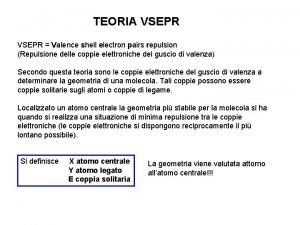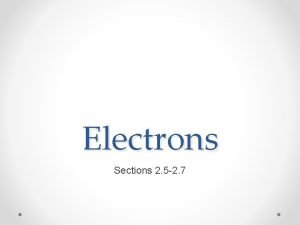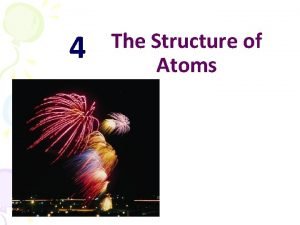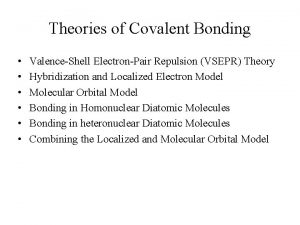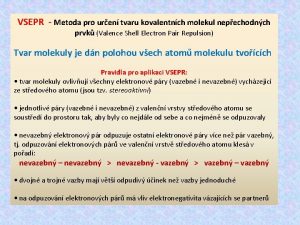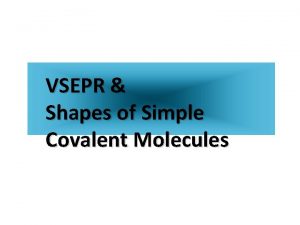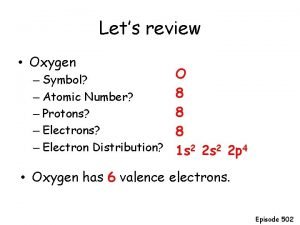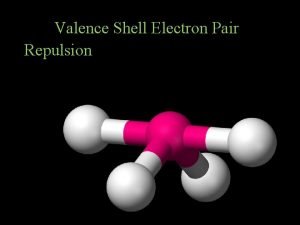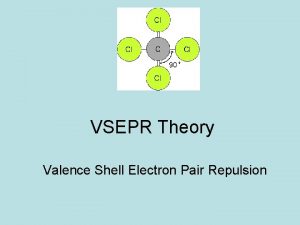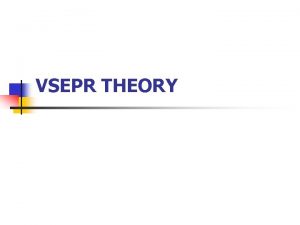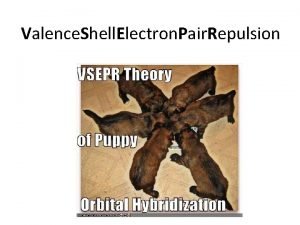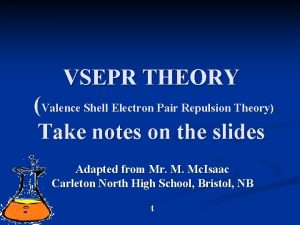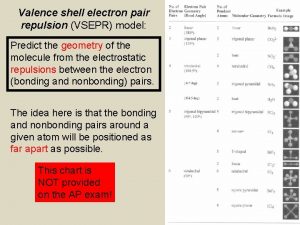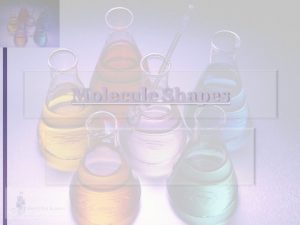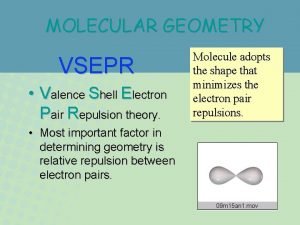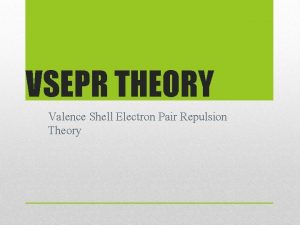Section 4 3 VSEPR Valence Shell Electron Pair











- Slides: 11

Section 4. 3

� VSEPR (Valence Shell Electron Pair Repulsion) �valence electrons stay as far apart as possible to minimize repulsion � Tells us the geometry of the molecule � When looking at a molecule we look specifically at the central atom (the one that has the most bonding electrons) to determine the geometry

� Only the valence shell electrons of the central atom(s) are important for molecular shape � Valence shell electrons are paired or will be paired in a molecule or polyatomic ion � Bonded pairs or electrons and lone pairs of electrons are treated approximately equal � Valence shell electron pairs repel each other electrostatically (“like repels like”) � The molecular shape is determined by the positions of the electron pairs when they are a maximum distance apart.

� The solid wedge represents atoms/pairs of electrons coming TOWARDS the viewer � The dashed wedge represents atoms/pairs of electrons going AWAY from the viewer

� First draw Lewis structures of the molecule, including the electron pairs around the central atom � Count the total number of bonding pairs and lone pairs around the central atom � Refer to table 1 on pg. 245 or Appendix C 3 to predict the shape

AX 2 Linear AX 3 Trigonal planar AX 4 Tetrahedral AX 3 E Trigonal pyramidal These are the major types. Others shown in Appendix C 3 include: AX 2 E 2 Bent AX 5 – Trigonal bypyramidal AX 6 – Octahedral AX 5 E – Square pyramidal AX 4 E 2 – Square planar


� What are the shapes of the following molecules: nitrogen trihydride dihydrogen sulfide methane boron trichloride

� Secrets �Sulfur we’ve been keeping: can have several different valence configurations: It is actually found in nature as S 8 Can have 2, 4, 6 unpaired electrons �Phosphorous Can have 3, 4, 5 unpaired electrons �Basically the larger the atom the more electrons it can have. �And some noble gases form compounds! � When in doubt use the method of adding up valence electrons from yesterday to determine the # of l. p. of e- on the central atom.

phosphorous pentafluoride bromine pentachloride xenon tetrafluoride sulfur hexafluoride

� Iodine dichloride ion (ICl 2 -) � Chlorine trifluoride (Cl. F 3) � Sulfur tetrafluoride (SF 4) � When you are done complete the worksheet. (we are working on this tomorrow too!)
 Shell cleanliness shell soundness shell
Shell cleanliness shell soundness shell Egg parts
Egg parts Geometria a cavalletto
Geometria a cavalletto Valence shell electron pair repulsion
Valence shell electron pair repulsion Valence electron configuration
Valence electron configuration Full valence shell period 3
Full valence shell period 3 Sof4 lewis structure
Sof4 lewis structure Silicon valence electrons
Silicon valence electrons Valence shell
Valence shell Ax3e molecular shape
Ax3e molecular shape Molecular geometry of pf3
Molecular geometry of pf3 Problem set three episode 502 answer key
Problem set three episode 502 answer key


